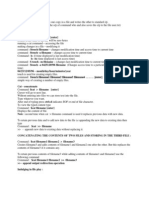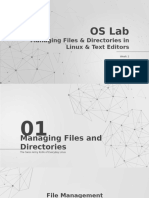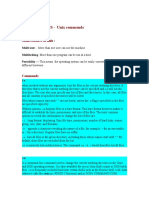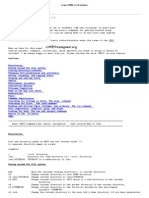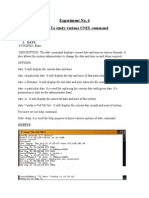Unix Basic Command
Uploaded by
chakrabortymayukh542Unix Basic Command
Uploaded by
chakrabortymayukh542UNIX Commands
Basic Commands
I File and Directory Related commands
1) pwd
This command prints the current working directory
2) ls
This command displays the list of files in the current working directory.
$ls–l Lists the files in the long format
$ls–t Lists in the order of last modification time
$ls–d Lists directory instead of contents
$ls-u Lists in order of last access time
3) cd
This command is used to change from the working directory to any other directory specified.
$cd directoryname
4) cd ..
This command is used to come out of the current working directory.
$cd ..
5) mkdir
This command helps us to make a directory.
$mkdir directoryname
6) rmdir
This command is used to remove a directory specified in the command line. It requires the specified
directory to be empty before removing it.
$rmdir directoryname
7) cat
This command helps us to list the contents of a file we specify.
$cat [option][file]
cat > filename – This is used to create a new file.
cat >>filename – This is used to append the contents of the file
8) cp
This command helps us to create duplicate copies of ordinary files.
$cp source destination
9) mv
This command is used to move files.
$mv source destination
10) ln
This command is to establish an additional filename for the same ordinary file.
$ln firstname secondname
11) rm
This command is used to delete one or more files from the directory.
$rm [option] filename
$rm –i
Asks the user if he wants to delete the file mentioned.
$rm–r
Recursively delete the entire contents of the directory as well as the directory itself.
You might also like
- Unix Commands: Simple UNIX Commands File Related Commands Directory Related CommandsNo ratings yetUnix Commands: Simple UNIX Commands File Related Commands Directory Related Commands29 pages
- Introduction To Unix: Unit 2:the File System and Some File Handling CommandsNo ratings yetIntroduction To Unix: Unit 2:the File System and Some File Handling Commands62 pages
- Command Description (Short) Example Explanation: Infile NamesNo ratings yetCommand Description (Short) Example Explanation: Infile Names4 pages
- UNIX BASICS - Beginners Guide For Unix Commands - by MeenakshiNo ratings yetUNIX BASICS - Beginners Guide For Unix Commands - by Meenakshi7 pages
- Linux Commands: Single Unit by Its Name. A Directory Is A File That Acts As A Folder For Other FilesNo ratings yetLinux Commands: Single Unit by Its Name. A Directory Is A File That Acts As A Folder For Other Files13 pages
- W COMMAND - Shows Information About The Users Currently On The Machine, and Their ProcessesNo ratings yetW COMMAND - Shows Information About The Users Currently On The Machine, and Their Processes7 pages
- UNIX Commands: CTRL+D - Possible Completer CTRL+C - Cancel Foreground Job CTRL+Z - Stop (Interrupted) A Foreground Job100% (8)UNIX Commands: CTRL+D - Possible Completer CTRL+C - Cancel Foreground Job CTRL+Z - Stop (Interrupted) A Foreground Job41 pages
- UNIX Command Cheat Sheets: Command Description (Short) Example ExplanationNo ratings yetUNIX Command Cheat Sheets: Command Description (Short) Example Explanation8 pages
- Unit-I Directory Commands 1. The PWD Command100% (1)Unit-I Directory Commands 1. The PWD Command19 pages
- Experiment No. 4 Aim: To Study Various UNIX Command: CommandsNo ratings yetExperiment No. 4 Aim: To Study Various UNIX Command: Commands34 pages
- Pharmsci571-Cadd: Essential Linux Commands: Some Important General Unix NotesNo ratings yetPharmsci571-Cadd: Essential Linux Commands: Some Important General Unix Notes11 pages



















